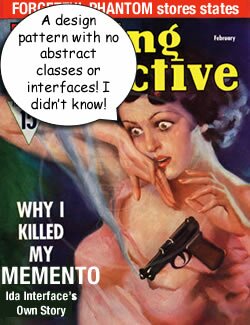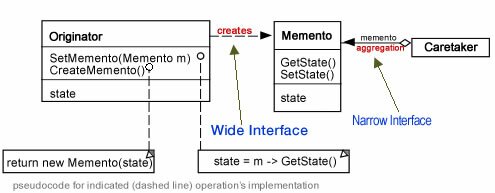 Where’s the Interface?!
Where’s the Interface?!
In going through Design Patterns: Elements of Reusable Object Oriented Software I found only three design patterns with no abstract class or interface parents: The Singleton, The Facade, and The Memento. I quit using the Singleton after several articles and even Erich Gamma said it caused more problems than it solved, and I have not had an occasion to use the Facade in a practical application (yet). However, I used the Memento pattern in the development of a script that controlled a streaming video. When the user decided that he/she wanted to remember a certain part of the video, the Memento would save the position of the video and would go back to that position if requested. The purpose of the Memento is to capture an internal state and store that state in an external object. It is the ultimate “un-do” pattern. You can save any given state, store it and then go back to it using the Memento design pattern.
Ironically, the major concepts to understand in Memento development are those of wide and narrow interfaces. Further, the Gang of Four note that this may be tricky with languages that do not support two levels of static protection. (As far as I know, PHP does not have that support, but I’ve developed a workaround that does the trick.) So, without further ado, let’s take a look at the Memento. Run the program and download the files if you’d like:
![]()
![]()
Saving State
The task of saving state is as simple as saving certain property values in a variable or array. For example, if you’re keeping score in a game, generally you just increment or decrement a variable. At some point you may wish to save a score and later on use it again. Let’s say that if a player reaches 100, you want to record that so that it can be used later in determining his/her character status. The Memento will do that for you and store a given state in a separate object, and the trick is to capture and retrieve that state without breaking encapsulation.
Without violating encapsulation, capture and externalize and object’s internal state so that the object can be restored to this state later.(GoF p. 283)
Figure 1 is the class diagram for that process:

Figure 1: Memento Design Pattern
It looks pretty simple, but it’s easy to get wrong, and if you look around on the internet, you’ll find plenty of bad examples. So let’s start with wide and narrow interfaces. (I thought you said it didn’t have interfaces!)
Wide and Narrow Interfaces
In most class diagrams, we will see a Client class—if not in the original class diagram, I generally put one in to use as a starting point. However, with the Memento, the Caretaker makes a request for a Memento from the Originator; so it acts like a Client. The Caretaker is supposed to act pretty much like a warehouse—it stores Memento objects, but it doesn’t alter their states. Then, upon request, it returns them.
Continue reading ‘PHP Memento Design Pattern Part I: Wide & Narrow Interfaces’
Recent Comments